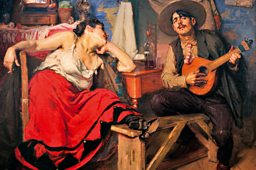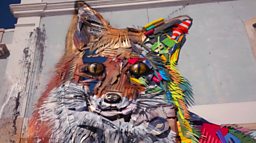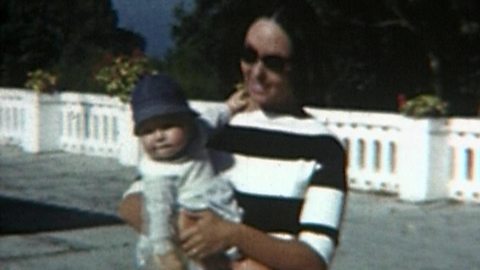From fascism to fado: Five fascinating ways to discover Lisbon
6 April 2018
With quaint trams running along cobbled streets and a picturesque shoreline, Lisbon is undoubtedly a visual delight for tourists.
But as JANINA RAMIREZ and ALASTAIR SOOKE discover in the first episode of the new series of An Art Lovers' Guide, there is a wealth of cultural riches to enjoy.
The city's charms are varied, with delights ranging from iconic 16th Century architecture to 21st Century street art.
Here are five of their top picks from the Portuguese capital.

1. Magnificent monument

A temporary version of the Monument to the Discoveries was first built in 1940 before being reconstructed in 1960 to mark 500 years since the death of Henry the Navigator, the prince noted for backing voyages of discovery.
It honours a number of Portuguese explorers and is important reminder of when the country was at the heart of the world economy, says Alastair Sooke. "Probably the most famous is Vasco da Gama, who discovered the sea passage to India, which completely transformed world history because suddenly the Portuguese controlled that trade route. All this wealth flowed into Lisbon, making this city extraordinarily powerful in its own right and extremely wealthy."
While it looks back hundreds of years, Janina Ramirez thinks it also tells us something about more recent Portuguese history. She says: "It’s an expression of nationalism and pride, and it’s got elements of fascist monumentality. It’s totally overblown - it went up under the Salazar regime, a dictatorship. In a way, it expresses so many of the contradictions at the heart of this city."
For Sooke, the huge sculpture covers two very different sides of the city’s character. "It feels like there are these crucial periods in Lisbon’s history, where Lisbon and Portugal are really outward-looking, literally exploring the world, but other moments when they’re very inward-looking, they’re isolationist, and I feel like this monument sums that tension up."
It’s an expression of nationalism and pride, and it’s got elements of fascist monumentalityJanina Ramirez
-
![]()
Portugal profile
Timeline of major 20th and 21st Century events
2. Fabulous fado

Sooke visits the Alfama quarter of Lisbon to find out more about fado, the musical style which thrived under the Salazar dictatorship, popularised by stars such as Amália Rodrigues.
He finds that the history transcends the close-mindedness of those difficult years. "Fado means fate, it's a style of music that developed in Lisbon in the 19th Century and expresses a kind of yearning, known in Portuguese as saudade."
At the Museu do Fado he gets up close to "probably the greatest painting of fado, an immensely stylish image painted in 1910 by José Malhoa.
"He went to this particular district of the city, this working class neighbourhood near the castle, and he found a fado singer called Amâncio. He was quite a shadowy character - as well as singing fado, he was a pimp and petty thief. This is probably one of his prostitutes, a woman known as Adelaide da Facada, Adelaide of the Stab Wound.
"But I don't think we're invited to judge these two people in a negative way. There's a sense of great commitment to their intimate, informal moment, there's great sincerity and authenticity to this picture.
"Adelaide is listening with such abandon, but it's abandon in the name of something that will allow her to transcend the grubby day-to-day reality of her job and take her to a higher plane full of yearning, melancholy and saudade."
Adelaide is listening with abandon, to transcend the grubby day-to-day reality of her jobAlastair Sooke
-
![]()
Hear a traditional fado
Portuguese fadista Ricardo Ribeiro sings 'Eu sei que sou demais'
3. Spectacular street art

Alastair Sooke discovers that Lisbon's walls have become the canvas for some remarkably innovative street art.
He visits the business district and finds the architecture has been completely transformed. "You've got these three really grand buildings but they're all derelict and they've all been covered with the most extraordinary street art, which feels utterly incongruous and out of place.
"But it's this great eruption of energy in the middle of an otherwise quite staid part of Lisbon.
"What I like about the street art I've seen in Lisbon is it's really quite inventive. This is a great example, it's created out of all sorts of junk and detritus. Here is this derelict building, which would be frankly an eyesore without this delightful fox with its quite cute eyes staring down.
"Suddenly this is something to come and see. This is an asset for the city.
"I doubt this particular spot next to the motorway, with the flyover and all of the traffic, would be on most tourists' bucket list, but this is a wonderful example of street art; this extraordinary mural on this derelict building is indicative of the booming street art scene in Lisbon."
Chiseling out beauty

Alastair Sooke meets Portuguese street artist Alexandre Farto aka Vhils
Renowned street artist Vhils chisels portraits on walls to create a new face of the city
-
![]()
More spellbinding street art
Bordalo II's Instagram feed
4. Beautiful Belém

Janina Ramirez is blown away by her visit to the Tower of Belém. "This is an incredibly beautiful building - you can see why it's a UNSECO World Heritage site.
"The tower was begun in 1515 just after the return of Vasco da Gama from India and was designed to defend Lisbon against attack.
"But this isn't just a symbol of defence, it's also an expression of the way that Portugal wants to project itself internationally.
"You've got these crosses of the Order of Christ. These were emblazoned on the sails and banners of the ships that went out. They would have been the first things that new parts of the world would see when the Portuguese ships arrived on their shores.
"And then you've got the armillary globe. This was a navigation tool. It's a really interesting symbol for Manuel to have attached his whole dynasty to so early on. But it sums up that sense that Portugal is all about exploration, navigation and command of the oceans."
An architectural jewel

Janina Ramirez explores the Tower of Belém by the river Tagus, Lisbon
One of the architectural jewels of the reign of Manuel I, designed to defend Lisbon.
5. Powerful prints

Janina Ramirez also takes short trip along the coast to the resort of Cascais to see the work of one her favourite painters at the Museu Paula Rego.
While Paula Rego is Portugal's most famous living artist, she has spent most of her life in Britain, in part to escape the repressive Salazar dictatorship.
Ramirez finds that despite Rego's exile, her connection to her homeland remained strong: "In fact some of her art has helped to change Portuguese law."
"These are the prints she made in 1998 when there was a big referendum to legalise abortion," says Leonor De Oliveira, a researcher who specialises in Paula Rego. "This was is a very important issue for Paula. She made this print in order to create awareness of this problem, that women had to have secret abortions."
Ramirez is extremely moved by what she sees. "I find them really gritty and disturbing. But they're part of everyday life in Portugal at this stage. Women were falling pregnant repeatedly and the men were not taking responsibility, so it was up to the women to find someone.
"It's almost like they're in a surgery but they're just chairs, domestic chairs. All of the things that should be in place to keep the woman safe and free from infection, there's none of that."
While the 1998 referendum failed, another was held in 2007 and now women can access legal abortions. For Ramirez, it's clear that the powerful images created by Rego helped to bring about this social change.
Balancing work and family

"It was brush or baby"
Rego paints because she has Secrets and Stories that she needs to get out.
-
![]()
Paula Rego's take on Disney
Nine big ballerina paintings, inspired by Fantasia
Watch the programme
-
![]()
An Art Lovers' Guide: Lisbon
In this episode art historians Dr Janina Ramirez and Alastair Sooke delve into the rich culture and hidden gems of Portugal's capital city.
More from An Art Lovers' Guide...
-
![]()
How art is helping Beirut recover from the ravages of war
Culture is helping the Arab world’s most diverse city to heal wounds.
-
![]()
Five fascinating ways to discover Lisbon
The delights range from iconic 16th Century architecture to 21st Century street art
-
![]()
Seven ways to channel radical Barcelona
The Catalan city is renowned for its rich cultural heritage and politically-charged art
-
![]()
Five cultural hotspots in Amsterdam
Things you must see in the Dutch capital
More from BBC Arts
-
![]()
Picasso’s ex-factor
Who are the six women who shaped his life and work?
-
![]()
Quiz: Picasso or pixel?
Can you separate the AI fakes from genuine paintings by Pablo Picasso?
-
![]()
Frida: Fiery, fierce and passionate
The extraordinary life of Mexican artist Frida Kahlo, in her own words
-
![]()
Proms 2023: The best bits
From Yuja Wang to Northern Soul, handpicked stand-out moments from this year's Proms













